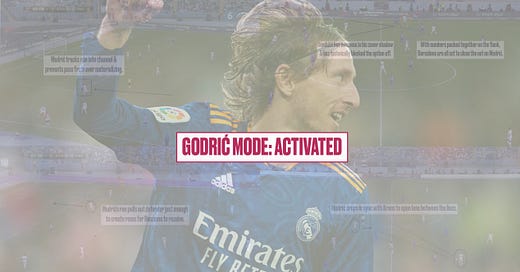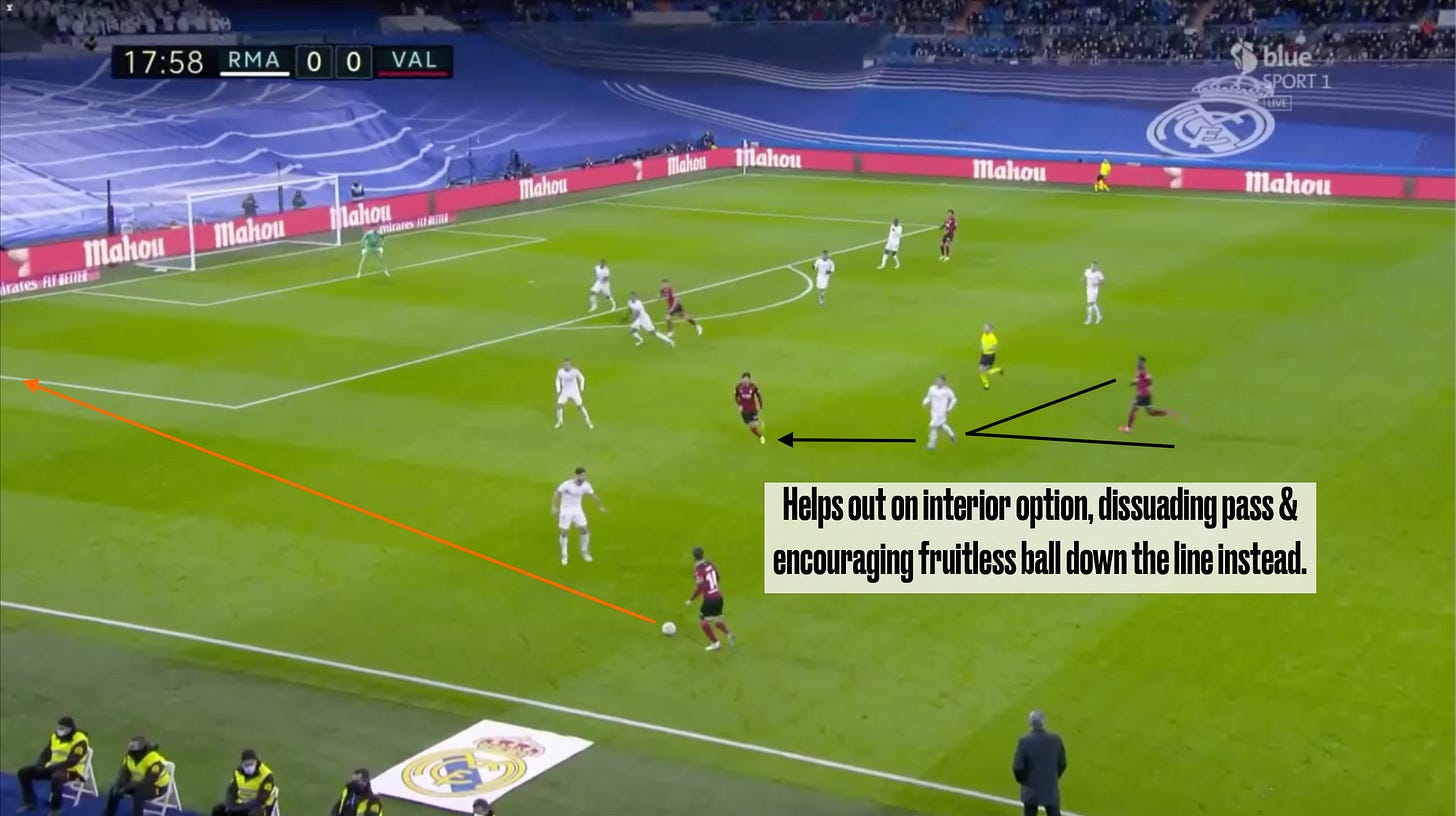In 2019, the footballing public thought Luka Modrić was done. A grueling run, which saw him collect a third straight Champions League title, a World Cup runners-up’ medal, UEFA and FIFA Player of the Year awards, and the Ballon d’Or, sapped what looked like the last of his stamina, burst, and mental sharpness.
As a result, he went into the post-Zidane and -Ronaldo era a shadow of his former self, accelerating the need for a transition to a new era.
Fede Valverde emerged as a starter in 2019/20 and reinvigorated Real Madrid with a physicality and energy that elevated Zidane’s 2.0 side into a brief, but legitimate, defensive monster.

The blueprint for the immediate future was set and an indirect Luka replacement had been found.
Except the formula didn’t translate into 20/21 with the same level of efficacy. Madrid dropped points where they had previously held onto 1-0 wins and it soon became clear that they needed a higher offensive ceiling to turn results. For all of Zizou’s experimentation and bold use of Casemiro and Sergio Ramos as open play box threats, the Frenchman fell short of an ultimate solution.
No matter what, his attack remained slow and plodding, primarily concerned with control over destabilization — due to an inability to foster both simultaneously — and oriented towards high-volume crossing regardless of Ronaldo’s absence.
Any further marginal gains would need to come from the players. Thus, with Fede suffering a series of knocks from November onwards, the path was paved for the return of a legend.
Zidane went back to his old methods and bet everything on his washed veteran, refusing to rotate Modrić and the other two members of KCM, much to the chagrin of many supporters. It was one of the better decisions the Bald Wonder has made over his career, even if Madrid fell shy of any silverware in that campaign.
Godrić Mode: Activated
How exactly Modrić managed to resuscitate himself will never exactly be known, but we have a pretty good idea based on modern advances in sport science and the Croatian’s spartan-like professionalism. However, it would be disingenuous and frankly disrespectful to his prime self to pretend that the 36-year-old is as good as ever.
Rather, he re-established a high baseline of performance that periodically peaks at rarified heights. He no longer dominates a season quite like before, but is a lock to give us intensely-nostalgic performances a dozen or so times a year. Given what other central midfielders can do, this pretty much means he’s still one of the best around.

Passing genius is what tends to be picked out for highlight reels and YouTube comps, and there was certainly plenty of that over a three-game stretch vs. Valencia (La Liga), Barcelona (Spanish Super Cup semi-finals), and Athletic Bilbao (Spanish Super Cup final) in January.
Passing
NEW VIDEO LINK
Outside-of-the-boot variations are a Modrić speciality:
NEW VIDEO LINK
These little moments of technical inspiration unlock improbable angles for progression, generating highly-contextual advantages; the potential for combinations inside a block, accessing free space, etc. — edges that are dependent on where and how the defense is positioned and forced to react.
It is in these subtleties that one finds a true appreciation for Luka’s impact. Unlike forwards or high-usage #10’s, central midfielders accrue value in more nebulous ways. It’s less about the one big line-breaking pass or assist (or not only about that) and more about the aggregate — an accumulation of marginal gains, obtained by passes like the ones above.
Looking more closely at the technique that undergirds his style reveals other things, such as how his execution is inextricably tied to his constant awareness. In high-tempo situations, Modrić will have mapped out everyone on the pitch and decided on the superior option before he even receives the ball. It’s that symbiosis between technical proficiency and mental agility that allows him to rack up slight advantages at a rate that surpasses almost everyone else in the game.
NEW VIDEO LINK
The benefits from this can theoretically arise in any sequence — it’s a persistent threat that oppositions have to reckon with. Rest defense has to be that much more organized and counter-pressure that much quicker, lest Modrić convert a turnover into instant offense via a single touch, having seamlessly switched from a defensive mindset to an offensive one (or maybe he wears both hats at the same time) in that ephemeral moment of transition.
I purposefully included two clips where the end result is ultimately unsuccessful or unremarkable to illustrate how Luka is always doing this. If goal scoring is about being in the right place all the time — instead of in the right place at the right time — then elite contributions in build-up derive from a never-ending process of elite execution in the hope that one sequence might finally result in a progression, which may result in a box entry, and, finally, a goal.
Rapid one-touch combos to break out of a press may not come off, possibly because two players aren’t on the same wavelength, but it enhances the chances for line-breaking. Receiving and returning passes in tight pockets may not always disorganize defenses, but it allows your side to probe relentlessly until it does.
It is for these reasons that the generational central midfielders treat each touch with immense care and thought, enabling them to record those wild statistical footprints — i.e. 101 attempted passes on 98% accuracy — that stand as testaments to their mastery of the mundane.
The attention to detail on each action can extend to the extremely subtle — taken-for-granted executions that create minimal, yet crucial, advantages.
NEW VIDEO LINK
Off-Ball Movement
What sets Modrić apart from many other ball-dominant, playmaking CM’s is how he broadens this care and focus to encompass his off-ball work.
NEW VIDEO LINK
The mental motor that aids his one-touch passing opens up a wide variety of zones for Modrić to exploit with his runs, particularly that right channel, which he has excellent feel for hitting as the fullback gets drawn out to the touchline.
Of course, the perceptiveness and tactical nous that aid his movement and one-touch distribution in isolation from each other also help the two function in tandem, especially vs. the high press:
NEW VIDEO LINK
Defense
Yet, what’s most underrated about the Croatian is his defense.
NEW VIDEO LINK
He stays constantly active and alert out of possession, using the fundamental mental tools that power his attacking genius to furnish turnovers and shut out danger before it ever materializes.
To be this committed to his defensive work at age 36 and while still possessing an incessant offensive work-rate is remarkable. The unbelievable nature of his longevity isn’t that he still has quality — it’s that he still affects all aspects of play at a high level.
And it’s that quintessential completeness that truly encapsulates the greatness of Modrić, having applied the aforementioned sense of care and consideration to more aspects of his game than perhaps any other central midfielder in history.
It’s also what gives him resilience against Father Time. As his body slowly wears away and those brief, nostalgic peaks continue to recede, his technique, cognitive skillset, and conscientiousness towards each action mean that he will always find a way to make an impact, whether that be through audacious chipped passes, wily body orientation, opportunistic off-ball movement, or committed, intelligent defense.





